Premiere for the iPad? A first look at Adobe’s new, multi-platform Premiere Rush CC software (VIDEO)
posted Monday, October 15, 2018 at 9:00 AM EDT

Adobe has been promising the merits of the "creative cloud" since they unveiled it, and even as late as last week, I was still not really seeing the benefits to the average user. Sure, thanks to their "teams" option, it is apparently easy to work with a group to complete a project with shared files and experiences, but because that is not something they have ever provided for review, no one in the industry has been able to speak to it unless they've been part of a larger project, like the creation of feature films. I've only ever heard that teams works, but never seen it in practice.
One could argue that we have gotten file access across computers thanks to CC and that Lightroom has done a few things to make mobile workflows a thing. But the file sharing system is no better than Dropbox, and the Lightroom syncing system is neat, but not professionally useful.
So those of us who praised Adobe years ago for deciding to go ahead with their Cloud idea were left scratching their heads as to why we were doing so. Nearly nothing has changed in the average photographer's workflow thanks to the Creative Cloud, so why do it in the first place?
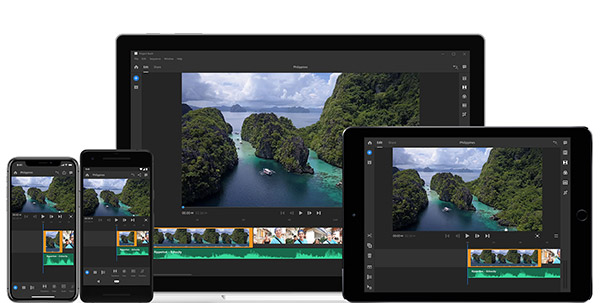
Today that starts to change. We saw glimpses of this change with the new Lightroom CC coming in to eventually replace Lightroom Classic, and we're seeing it again now with Premiere Rush. Though Rush is a far cry from what is possible with Premiere Pro, the workflows that Adobe are building show that the dream of "cloud" actually meant something.
In 2013 I spoke to Jeff Chien, one of the lead Photoshop engineers who personally crafted several iconic Photoshop tools, his most famous probably being Healing Brush. Looking back at my interview, it's clear that at the time, even Jeff wasn't really sure what it meant to take Adobe into the "cloud," only that it was their directive and it was their job to make that mean something. Back then, Jeff didn't really have a solid answer for me when I asked him what the future looked like for Adobe, only that he was excited to craft that answer over time.
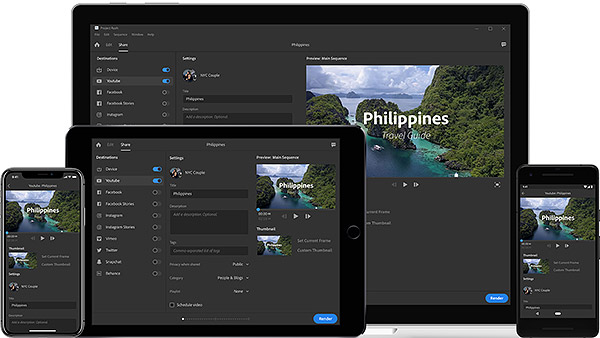
Five years later, I think it's finally starting to take shape. I think looking back at it, Adobe was too ambitious at the time. The technology surrounding their idea of what Cloud could be just had not advanced to the point necessary in order to actually power their ideas. Personal mobile devices were dramatically underpowered, and you couldn't do nearly what you can now on the iPad of 2013. So was it fair to jump into the "cloud" so soon? A debate for another time.
Today, in the latter end of 2018, I think that Adobe's trials and tribulations on what "cloud" meant over the last five years has finally resulted in a product that the average consumer is going to notice. Premiere Rush is, today, a bare-bones video editor with just enough features for a low-end video editor to be satisfied. It's not yet at a place where a Premiere Pro user can seamlessly swap over to it, but it can get there.
If you've used Premiere Pro in the last couple of years, you probably have realized it's not the most stable platform, and it's also not the fastest. Years ago Adobe bet their software hand on a certain software architecture being the wave of the future, and they were not right about that. Computers ended up going a totally separate direction, and as a result, the base code of their programs was not optimized to run on the computers of today. Final Cut X looked and functioned poorly when it first came out because Apple bet their hand on a different software architecture and therefore had to totally rebuild their platform for it. Each feature needed to be totally rewritten, and in order to do that they had to throw out what they built previously. Adobe wasn't willing to do that and paid the price in performance later. Now, Final Cut runs beautifully on modern Macs while Premiere sputters behind.
I think Rush is Adobe's attempt at a slow rebuild of the Premiere platform so that we can get the benefits of it slowly without fully dumping out Premiere Pro as it is now. This is the same case with Lightroom Classic, as Lightroom CC is a new software architecture. All the features you know and love need to be totally rewritten for it, and so both platforms remain available until the original program can be retired in lieu of one more suited to the modern day.
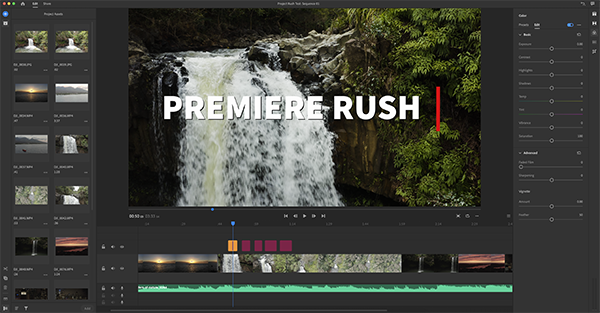
Looking at Rush now, it runs really nicely. There is not a lot to review here, because honestly there isn't much functionality other than basic non-linear editing. You can move clips around, put a transition between them, add titles and music, and export to any setting you could possibly need. But the color grading tools are well below the Premiere Pro standards, there are scant few effects (like Warp Stabilizer), and I still can't figure out how to do a custom speed change to the footage.
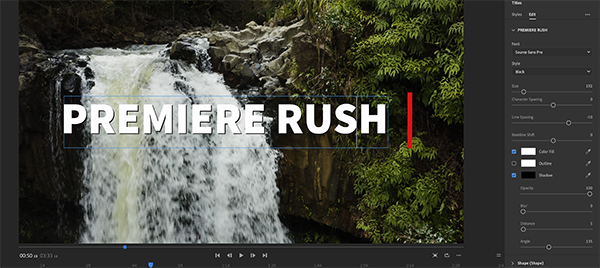
But it will get there. Rush looks good. It runs well on both my iMac and my iPad. Big, 4K files actually don't take long to sync, and I get useful proxies on my iPad within minutes of adding the full resolution files to my Rush file on the desktop. And I do mean within minutes. Under 10. The upload to the cloud from my desktop and then the download of all the files to my iPad took no time at all, and all changes made on one affected the other. It works fast, seamlessly, and exactly as you would hope.
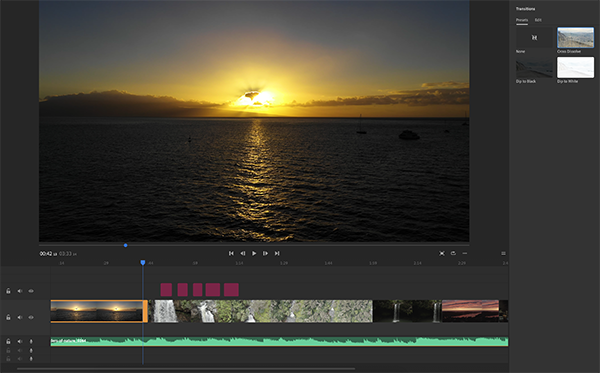
A note: My Apple keyboard for the iPad Pro doesn't yet work with Rush, so I find myself going for my keyboard shortcuts often to no avail, but this program is clearly a work-in-progress at the moment and will get there. I wish I could just hit spacebar on my iPad keyboard to start and stop video playback, but it can't do that right now. But it will, surely, get there. And when it does, it'll have the capacity to change entire workflows for the average video professional.
You can make basic transitions (three basic transitions: dip to black, dip to white, and cross dissolve), do basic color adjustments (but you cannot upload your own LUTs) and save adjustments as presets to access later, and lightly tinker with sound. There isn't a lot of depth to what you can do in Premiere Rush yet, but for a very basic video editor, there is enough here to make something simple.
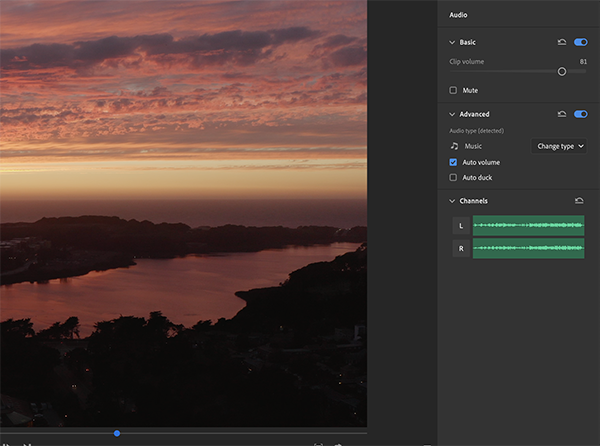
In my opinion, Rush's ability to render footage in the background is likely its best feature, usability-wise. It's something you have to enable manually in your preferences, but it makes videos run much more smoothly during editing. As Rush grows into its own, this feature is going to make it really special.
What's more, Adobe says that Premiere Pro recognizes Rush files and can open them as Premiere documents, but I wasn't able to test this because I couldn't figure out where Rush was storing its files on my computer. You aren't asked to set up a save location when starting new projects like you are in Premiere Pro, so I'll have to dig around to see where Rush is deciding to place its files.
Here is how pricing breaks down:
Premiere Rush CC is available for $9.99/month to individuals, $19.99/month to teams, and $29.99/month to enterprise customers. Premiere Rush CC is also included as part of Creative Cloud All Apps, Premiere Pro CC single app, the Student plan, and comes with 100 GB of CC storage. Additional storage options, up to 10 TB, are also available for purchase.
So the question becomes... is it worth it? If you already are paying for CC in one of the ways Rush is included, then yeah it might be worth it to play around. But if you are already using Premiere Pro, the only way you get Rush as part of the deal is if you're already buying a package that includes Premiere. If you're doing that, then you probably know how to use Premiere Pro and like it. Therefore, Rush doesn't have a lot to offer where you would find yourself using it. It's a starter program right now and isn't robust enough to compete with Premiere Pro. If you don't get Rush included with your CC subscription, then I don't know that I can say it's worth paying to add it. For $10 a month, it's a really underpowered program. You might be better off going for Premiere Elements right now to do video editing because it's probably cheaper in the long run and you have more options. The $20 a month price for teams also doesn't make a lot of fiscal sense, since Teams are probably high-level users who want a full-featured program. Frankly, Premiere Rush isn't that.
So right now, at launch, Premiere Rush CC is just a very good idea and a physical example of what we were promised in 2013. I'm very happy that Adobe has finally gotten us to this point, but Rush just needs more features to be truly usable and complete at its price point. Adobe now has three separate video editing services: Premiere Pro, Premiere Elements and Premiere Rush. Of those three, only Rush has the interconnected, multi-platform usability that is so cloud-focused. However, of those three, Rush is also the program with the fewest number of actual editing features. For video professionals, and even enthusiasts, it's hard to take connectivity over editing features right now. Sure, connectivity is awesome, but it's not more important than features.
We'll keep a close eye on Rush as it evolves over the coming months. For now, it's a great idea with a ton of promise, and it's a program that's finally painting a complete picture for me on what Adobe's cloud is able to be.